BY DANNY STRATTON
Firefighters working above the fire floor are in the most dangerous location at a structure fire. The convective energy, fire, smoke, heat, and steam from the fire streams tend to move in a vertical direction, making operating above the fire a challenge. The fire can eat away at the load-bearing structural supports, weakening the structure’s load-carrying capability. The interior firefighter must be able to identify hazards and know how to execute precautions to prevent death and injury when operating in such a vulnerable position (photo 1).
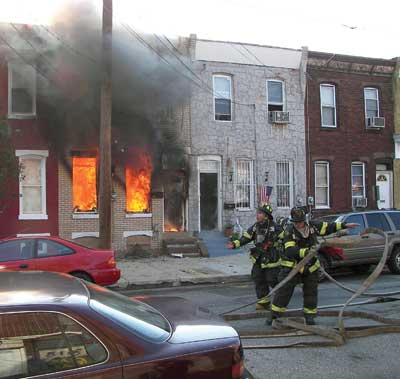 |
| (1) A fire on a lower floor with its tendency to spread upward, not to include other influences, poses a threat to firefighters operating on floors above. (Photos by author unless otherwise noted.) |
AWARENESS FROM PREVIOUS FIRES
We must make every effort to improve the way we operate by applying what we learned from past incidents so we can operate aggressively with confidence. The following incidents, which involved working on a floor above the fire, deserve our attention.
• January 23, 2005. Six Fire Department of New York firefighters jumped from a fourth floor of an apartment building when the fire from a lower floor engulfed the floor on which they were operating. The fire, which was believed to be wind driven, rapidly consumed the stairway that was their only egress. Six firefighters made the 50-foot jump for their lives; unfortunately, only four survived with injuries.
• January 19, 2011. In Hillendale, Baltimore County, Maryland, two firefighters were trapped on the third floor of an apartment building where the fire involved the first floor initially. One firefighter escaped by bailing out using a ladder; however, another did not make it out alive.
• February 29, 2012. In my department in Camden City, New Jersey, four firefighters, who were above a cellar fire, had to jump out of windows. Crews were advancing toward the fire in the below-grade area when explosions were heard. The explosions propelled hot gas throughout the upper floors of a two-story twin home, forcing firefighters to make a hasty escape. On the first floor, two firefighters quickly escaped through a window; two others bailed out of a second-floor window. Two of the four firefighters were transported to the hospital with minor injuries. Several other firefighters on the first alarm, including me, had to quickly exit by doorways to the exterior (photo 2).
 |
| (2) Camden City, New Jersey: A first-alarm response crew had to rapidly egress a structure when an explosion occurred in the cellar, propelling by-products throughout the upper floors. Four firefighters had to escape by windows. (Photo by Phil Cohen.) |
According to a United States Fire Administration report based on data from the National Fire Incident Reporting System (NFIRS) for the years 2006 through 2008, the majority of firefighter injuries, 87 percent of 39,715, occurred inside structure fires.
Firefighter fatalities in the line of duty in the United States for the years 2011 and 2012 (this year’s numbers were provisional when this was written) were 83 fatalities for each year. These were the lowest firefighter death rates since 1993, when there were 82 firefighter fatalities. An analysis of the 2011 fatalities revealed that 28 firefighters lost their lives while operating on the fireground. Twenty-one were related to structural firefighting. Ten were caught or trapped; seven of the 10 perished in wildland or outside firefighting; the others were operating inside a fire structure.
For an intriguing story of survival, refer to “Texas Mayday,” Fire Engineering, December 2012, page 49, http://bit.ly/19HXtT8. The author, Captain John Wright, narrates his personal experience in getting caught up in conditions when above a fire floor.
HAZARDS AND PRECAUTIONARY MEASURES
The greatest precaution against becoming a firefighter fatality or injury is to apply water on the fire as soon as possible. When operating above the fire, you have to guard against the fire’s spreading upward and trapping crews. It is imperative to get a stream on the fire immediately. Once the air brakes on the engine company apparatus engage, a competent attack group should have a stream on the fire in less than two minutes.
At a minimum, knock down the main body of fire. This will cut down the main source of energy pushing fire upward and throughout the structure. Case study after case study in which there have been firefighter deaths identify problems in conducting such a routine strategy. Most engine companies have at a minimum 500 gallons of water, which is enough to make a knockdown on most fires. It may not totally extinguish the fire; however, it should slow the momentum of the fire’s self-sustained energy. The tactic with the highest priority that saves the most civilian and firefighter lives is placing a stream on the fire expeditiously.
When operating above the fire floor when an open interior stairway is present, the stairway most likely will be the primary avenue for vertical fire spread. It will cut off a means of egress and cause the fire to consume the floor on which a crew without a protective hoseline may be searching for fire victims (photo 3).
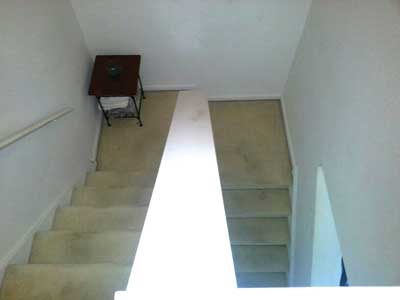 |
| (3) The unprotected open interior stairs serves as a readily available vertical avenue for by-products of combustion to compromise firefighters on upper floors. |
If the stairway is in an apartment building and up to code and doors are present but not closed for whatever neglectful reason, make an effort to close the doors for your protection. Also, close the door to the room or apartment in which you are searching; the containment can help slow the fire spread.
If possible, have a roof group open up directly over the stairway to provide vertical ventilation. This action will channel by-products up and out-where fire prefers to go-in a vertical direction instead of horizontal on upper floors where firefighters may be operating. The roof crew may be able to take advantage of the natural opening directly above the stairs such as a regular door opening, scuttles, and skylights to channel by-products. If no such openings are available, a fast and efficient roof team could cut an opening over the stairway (photo 4).
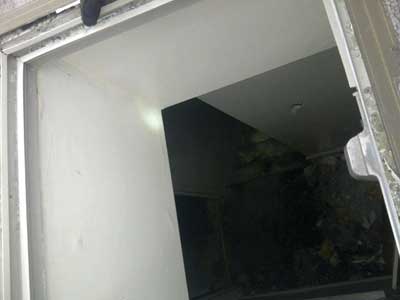 |
| (4) The roof man can take advantage of natural openings over stairways to direct fire, smoke, and heat away from crews on upper floors. |
The best precaution to protect crews from stairway fire spread is to commit a fire stream to protect the stairs. Confining the fire is the first priority of the initial attack group. In confining, we are ceasing the fire’s forward progress to uninvolved areas. The attack group’s priorities are to protect occupants needing rescue, the open interior stairs, and firefighters operating without the protection of a hoseline. The latter is of most importance.
In a single-family dwelling with a fire on the first floor, giving the stairs immediate attention takes care of the three concerns. In apartment buildings with open unprotected stairways, the incident commander (IC) has to give priority to placing a hose team to protect the stairs. If you lose control of the virtual vertical chimney, you can lose the building and jeopardize your people conducting search and rescue on the upper floors.
Another concern is that autoexposure (the fire’s lapping upward from an opening below) can compromise firefighters on upper floors. The space between the opening from which the fire is exiting and the opening above through which it will enter can serve as a cut-off for stopping spread. If the exit and entering points are both windows, this space is called a spandrel (photo 5).
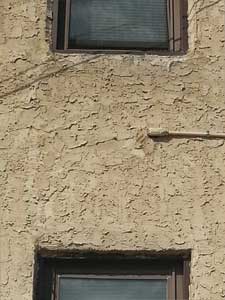 |
| (5) A spandrel. A stream can be placed in this space between two windows to stop the fire from extending upward (autoexposure). |
If there isn’t a hoseline on the upper floor in question, a hose team can place a stream from ground level. Sweeping this wall space with water can stop fire spread to the upper floor. The crews operating on the upper floor can request this stream action if a hoseline is available to go in service immediately. Actions that can be executed more quickly, however, include closing windows and removing curtains, blinds, drapes, and furniture. The combination of containment and removing fuel will slow or cease the spread altogether.
The presence of voids can compromise firefighters above the fire. Service voids include laundry chutes, dumbwaiter shafts (photo 6), and trash compactor shafts, which contribute to the vertical spread of by-products. Enclosed voids like pipe chases, ductwork, stud spaces, and steel channel rails, if opened, can discharge by-products to another floor.
 |
| (6) Closing vertical service voids with fire in them, such as this dumbwaiter shaft, can stop fire spread. |
When faced with voids, take precautions. Attempt to contain vertical service openings such as trash compactors or laundry chutes. If possible, close the vertical opening if there is some type of door. If there is no method of self-containment, close the door to the room that serves the vertical shaft. Also, close windows in the area. Closing the windows and doors may redirect the fire up the void instead of into the room. Open windows and doors create a path of least resistance. The roof team’s opening the shaft from above and your containment measures will make the fire bypass the floor in peril.
When dealing with enclosed voids, resist the temptation to open them without a working hoseline at the ready. A firefighter opening a wall runs the risk of by-products cutting off egress or ejecting from a void with explosive force. In Union City, New Jersey, in September 2006, Firefighter Vincent Neglia of North Hudson (NJ) Regional Fire and Rescue died when fire forcibly blew out of the large vertical void, which he may have opened up. The fire engulfed the third-floor apartment in which he was operating (photo 7).
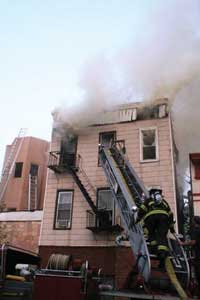 |
| (7) This fire claimed the life of North Hudson (NJ) Regional Fire and Rescue Firefighter Vincent Neglia. A fire in an enclosed vertical shaft was believed to be a factor in the fatality. (Photo by Ron Jeffers.) |
Don’t forget that fire travels up above; it can travel up the wall into a ceiling area or an attic space above your location. If, for example, fire on the first floor of a two-story dwelling travels up a pipe chase into a roof and forces it to the top floor, don’t take the initiative to check for extension. The fire may weaken the structural supports and collapse a ceiling or possibly roof material down on firefighters.
Another possible hazard, which is extremely rare, is the accumulation of hot gases from the fire below in an attic space. These gases can be oxygen starved, waiting for a truck firefighter to sink a hook into the ceiling, which can introduce air and result in a fiery explosion. The ceiling, and maybe even the roof, could collapse onto personnel below, trapping them.
To stay safe, fire suppression personnel should have knowledge of building construction and specific information of the fire structure in which they are working. Use this information to anticipate the spread and get ahead of the fire. Use a thermal imaging camera (TIC) to examine the walls and ceilings. However, don’t always totally rely on this tool. Make small inspection holes in the probable horizontal avenues and the ceiling above.
The TIC does not get a reading if the surface of the camera is locked or doesn’t have a temperature change. The use of insulation materials, double-thickness gypsum board, and other interior finishes may not make it possible to get a heat signature. Furthermore, if heated smoke from the fire below travels up through the stairway, it can heat up the wall and ceiling coverings on upper floors, which may give a heat signature on these surfaces the TIC will pick up. This doesn’t confirm that fire is in the voids; chances are that there will be no fire behind the material when you open up the coverings. To be clear, a heat source in a room can heat up wall and ceiling coverings, giving a heat reading on a TIC that is not a reliable sign of fire spread behind the covering. The only true method for detecting fire travel in voids is to perforate the material and examine the void.
Caution: Be mindful in the timing and location when ventilating at a structure fire. Prematurely ventilating can aid in the spread of and increase the intensity of the fire, which can be dangerous for firefighters in and above the fire floor. Incorrectly placing a ventilation opening can pull by-products to an area of the structure where they will endanger firefighters.
Be sure to communicate with attack groups to ensure that a charged hoseline is in position before opening windows and doors. If making an opening before a hose team is available, be sure to implement a containment measure. In forcing a door, make sure you will still be able to close the door-don’t breach it or remove it off its hinges. If necessary, you will be able to shut the door to contain the fire; use a piece of rope, a chain, and channel locks; or preferably reach a tool to close the door, if needed, after forcible entry has taken place.
When it is necessary to force a window prior to committing a hoseline, close the door immediately. You may have to force a window to search for a victim or when a firefighter needs to bail from a window. The closed door will stop the fire’s spread to the location and give personnel some time to perform their task.
Wrongly placing an opening can pull the fire into a hazardous location for personnel-for example, a fire on the first floor on the right side of a two-story dwelling and an overly aggressive roof man opens a skylight on the left side of the home. The fire travels from the right, up a stairway, onward to the left side of the dwelling, and out that roof opening. The fire can overcome crews in its path who are searching for victims on the second floor without the protection of a hoseline. An opening placed directly over a fire doesn’t require timing; however, an opening away from the seat of the fire can dangerously pull fire to uninvolved areas.
The wind can be an influential motivator in the spread of fire. It can intensify the fire by supplying more oxygen, thus increasing heat release. As fast as a flash of lightning, fire can spread through the structure. Firefighters should anticipate not only how a fire will spread throughout a particular structural type but also the speed at which it will spread under the influence of a brief breeze.
The loss of water has to be extremely frustrating to a fire suppression crew. The rapid deploy of a stream on the main body of fire can be delayed by a burst section of hose, a kink, an obstruction in the hoseline, and an inexperienced pump operator. Good maintenance and testing procedures per National Fire Protection Association standards and manufacturer recommendations will prevent an unexpected hoseline rupture.
As an additional precaution, remove attack hoselines off the pumper and charge them on a regular basis. The chances are that the hoseline will burst on the apron in front of the fire station instead of on a front lawn of the next working fire with firefighters engaged inside without protection. Hoselines can sit on a rig for months in a folded position without water running through them enough. The hose can be susceptible to dry rotting of the inner liner, or its outer jacket may be pierced by a sharp foreign object in the bed.
A major structural concern when operating is the decking on which crews are operating. The hazards can be as minor as holes in the floor’s surface or as serious as fire impinging on the structure’s joists and causing them to fail or perhaps the failure of a wall on a floor below as a result of the fire’s causing the floor above to release. The personnel on the floor above could suffer not only from trauma by falling but could also be severely burned if they fall into fire below (photo 8).
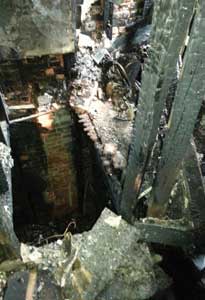 |
| (8) When on a floor above the fire, keep a heads up for holes and openings on the decking, and take precautions if you find one. |
Holes in the floor can be preexisting or the result of fire breaching the material. A firefighter unaware of them can fall in or, worse, fall completely through. If visibility is good, pay attention to your step; be on the lookout. If visibility is poor, crawl and use a technique for feeling the floor in front of you as you advance-place your hands out in front of you, extend a leg, or extend a hand tool in front of you. If crawling is not desirable because of a hot decking or the possible presence of needles from drug users, use a hand tool to pound the floor in front of you while moving cautiously forward.
If you discover holes on the work platform, communicate this information to others on the fireground, noting the location of the breached decking. Try to cover up the hazard; remove a door from its hinges and place it over the hole, use a ladder to bridge over the flaw, or prevent personnel from operating in the area by either roping off the section or assigning a monitor to warn the firefighters.
To protect suppression forces from the failure of floor joists, monitor and anticipate fire spread in the voids. Study building construction, and fall back on that knowledge to predict and take action. Using a tool or a stretched-out extremity can ensure stability ahead when you are moving forward on a questionable surface. The firefighters below should check by opening up with tools in the ceiling space and extinguishing any fire in the floor joist. Be sure to communicate with the crews below to determine the fire’s status.
Using the TIC may help as long as there aren’t too many floor coverings. Hardwood floors can make it easier to get a heat signature on the floor. You can open the floor to monitor conditions, but it will be arduous because of the floor coverings. It’s much easier to check underneath on the floor below because ceiling coverings are usually easier to remove.
On the exterior, open up the exterior wall and rim boards and place a stream into the joist area to knock down the fire. This is a good tactic for trusses. It won’t be as effective on wooden joists and wooden I-beams because they do not provide a large open area.
When operating on upper floors, means of egress can be scarce; chances are there is only one stairway. This sole escape route can become involved with fire, negating it as a retreat area. The only alternative would be to exit by window.
The best precautionary measure when window egress may be warranted is to aggressively ladder the fire building. ICs should make it a rule to get aerial devices and ground ladders on a structure. It’s a good policy for search groups to place one or more ladders before committing to searching the interiors on upper floors. This strategy will ensure more than one egress.
When operating inside on an upper floor, be sure to find a second and other means of egress. I advocate that when firefighters enter a floor they take a direct route to a location directly opposite the point they entered to find another means of escape before they initiate their search. This ensures another means of escape at the opposite end should a deteriorating event cut off the entry point.
If water is flowing on the fire and conditions permit, forcibly remove the window; make it a “doorway” for easy egress. If a window is converted into a door before the attack group enters, choose a room where the door can be closed. This will keep the fire from spreading. Pick a window that has been laddered. If one is not present, a rooftop protruding from the floor below or a porch roof can be used as a temporary place of refuge.
Another detail that needs to be considered is the height of the structure in which you are operating. Operations in high-rises can make it impossible to provide egress with ladders. The only option firefighters will have is to exit by rappelling if an interior exit isn’t available. There are various rappelling techniques for egress; firefighters must be comprehensively trained in them. A firefighter should have at a minimum a 40-foot piece of rope to initiate a rappel in which he is using his torso as a friction device.
MORE PRECAUTIONS
On a floor above the fire, there are still more precautions suppression personnel should take to ensure safety from death or injury. The next best solution to placing a stream on the main body of fire is deploying additional attack hoselines on the floors above. Departments should ensure their first-alarm assignments have enough resources so they can deploy multiple handlines on structures that are three stories or more in height.
Consider having your breathing apparatus turned on and your face piece on your face. At times, upper-floor conditions can be perfect; there is no smoke or even a haze. However, the upper floor can become filled with fire or hot smoke in seconds. All a firefighter would have to do is place a regulator on his mask to keep from breathing in dangerous by-products of combustion.
Be sure to maintain your orientation should conditions change rapidly. Note the location of the windows and even the doors to the exterior in case you need to egress in haste. Consciously, be aware of the presence of a wall; use it as your guide, especially when working in compromised visibility. If your vision is not compromised by smoke, you can still use the walls for guidance. It will be helpful in making a systematic search; more important, if conditions deteriorate, you can go to the wall to egress back to a safe haven.
When operating in such a dangerous location, having a pressurized water extinguisher can be a lifesaver. It will not extinguish a fully developed fire, but it can reduce the energy of the fire and buy personnel time to take other measures to evade danger. Apply the small stream into the overhead of a flame front, and it should reduce the energy.
The use of a personnel accountability system is vital. Make sure your location is known at the command post, particularly if there is a dedicated accountability officer. The rapid intervention team (RIT) should have an idea of your location as well, should an emergency arise. The team can be proactive to ensure your egress, and their access can be made to effect rescue of distressed firefighters by placing ladders and forcing entry.
If there are window obstructions such as bars on windows and child-restraint bars, give them priority, and have them removed. An assigned company or a RIT can remove window bars from the exterior using a saw, a torch, or a rebar cutter (photo 9). Crews operating on the interior can remove the child-restraint bars, which are mounted on the inside.
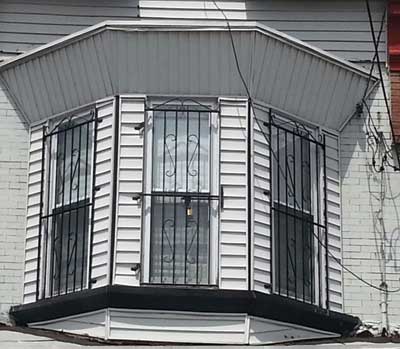 |
| (9) The emergency egress of a firefighter trapped on an upper floor will be delayed or prevented by bars on windows. An outside vent group should be proactive in removing these obstructions. |
Firefighters can have at their disposal the option to rappel. A personal harness equipped with rope would be needed. A firefighter or department should consider purchasing this equipment to improve safety. An added accessory, a firefighter escape system, is incorporated into the personal harness. It is attached to a harness by an escape cord with a hook for capturing an anchor. The cord is connected to the harness by the key device (fall protection device) in the system. The device, when engaged by a user’s hand, will unlock, allowing a firefighter to rappel down and away from danger. This equipment provides the fastest way for a firefighter to rappel out of an untenable floor.
If assigned to an upper floor to conduct a primary search without the protection of a hoseline, certainly do so to protect life. However, when your systematic examination for life has been completed and water has not been discharged on the fire on completion of the search, relocate to a safer area. This may mean totally evacuating the floor or structure.
If there is not a total evacuation, crew members can position themselves somewhere inside the building as a protective area of refuge, such as a protected stairway or an exterior door to an exterior stairway. A good tactic is to position yourself at a laddered window in a room with the door closed and to wait until water is applied to the fire. Be sure to convert the window into a door for ease of escape.
A great safeguard for firefighters operating on a floor above the fire is to preplan. Knowing the layout, construction type, and status of the building’s use can help you in making decisions. Analyzing premises before an incident can aid fire suppression personnel in size-up when they arrive at a structure fire. Make it a priority to get out and gather information on the structures to which your department may be called. This information can be a lifesaver.
On the fireground, understand strategies and tactics to be implemented at a structure fire. Prior knowledge on how to attack a fire based on conditions present from a well-informed size-up of the fire and structure will keep crews safe. When firefighters find themselves in a compromising situation, the reasons usually are a breakdown in command and control and a terrible action plan.
Editor’s note: For related video, go to http://bit.ly/1k1lzcs.
REFERENCES
http://www.usfa.fema.gov/downloads/pdf/statistics/v11i7.pdf.
http://www.atf.gov/explosives/programs/research-development/fire-research-lab.html.
http://www.usfa.fema.gov/downloads/pdf/publications/ff_fat11.pdf.
DANNY STRATTON is a 26-year fire service veteran and a captain with the Camden City (NJ) Fire Department. He has served as a firefighter in the volunteer and career fire service and the United States Army. He is a course coordinator at the Camden County Emergency Training Center and an instructor for Safety and Survival Training LLC. He is a rescue specialist with NJ-TF1 and has a double associate degree in fire science.
Fire Engineering Archives

